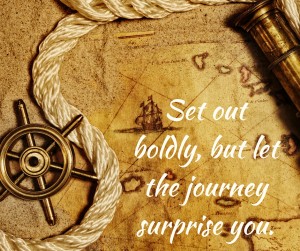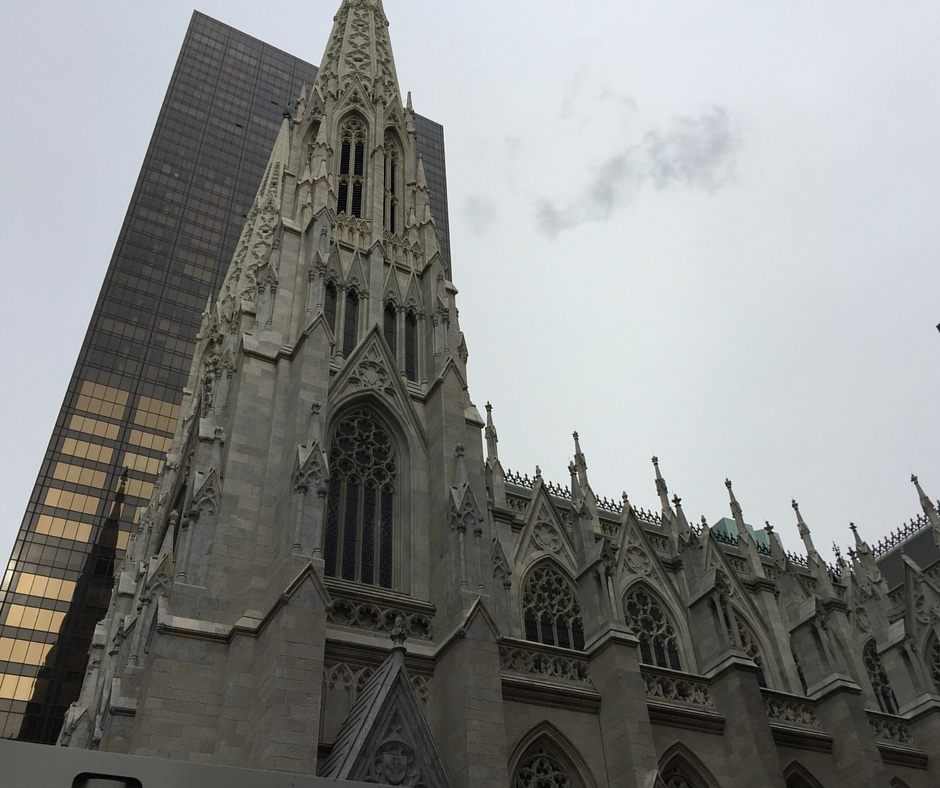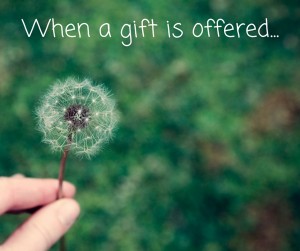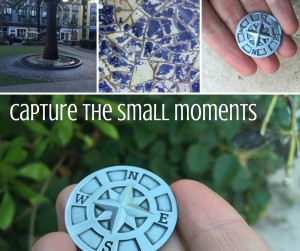by Naomi | Feb 26, 2016 | Creative Life
 Dorothy wanted to find her way home. Harry Potter longed to have his parents back. Luke Skywalker craved an epic adventure. These desires were strong, strong enough to cause Dorothy, Harry and Luke to take action and say yes to the unknown. But by the end of these stories, the goals the characters started out with had changed, grown, and transformed.
Dorothy wanted to find her way home. Harry Potter longed to have his parents back. Luke Skywalker craved an epic adventure. These desires were strong, strong enough to cause Dorothy, Harry and Luke to take action and say yes to the unknown. But by the end of these stories, the goals the characters started out with had changed, grown, and transformed.
One of the most important things my writing has taught me is about the dynamic nature of goals. Namely, I’ve learned that in the best stories, the adventure transforms the goal. Characters may not end up with everything they originally wanted, but they do end up with what they need. Let’s put that a different way, into real life terms.
When we set out to pursue a goal, we may not gain everything we originally wanted, but if we commit fully, and hold our goals with open hands, we will likely end up with what we need.
I have to say, if there is a way for me to gain “what I need,” I’m definitely all for diving in fully. How about you?
Let’s break this down a bit and take a look at what dynamic goal setting looks like.
DECIDE TO TAKE A JOURNEY: First, we check in with ourselves and listen to what is calling our hearts. We ask: What am I longing for?
DRAW YOUR MAP: Then, we set the best goal we can, given the information we have. We write the goal down and post it visibly.
START AT THE TRAILHEAD: Next, we commit fully. We aim for the goal and give the process our full effort. We research and discuss our goal with experts and learn and take action.
LISTEN TO FELLOW TRAVELERS: Now here’s where dynamic goal setting differs from traditional goal setting. Rather than putting up our blinders and pushing on no matter what, we listen. We pay attention to unexpected opportunities that arise. We don’t put in our ear plugs when people we trust challenge us to see our blind spots.
NOTICE THE SIGN-POSTS: We are thoughtful about sidetracks, shortcuts and complete re-routes. We don’t follow every shiny object. We watch for patterns. Most importantly, we take time to slow down and reflect on the question: Is this where I need to go next?
JOURNEY ON: We continue to move forward confidently, allowing our destination to shift as needed, and making sure to collect all of our learning along the way.
CELEBRATE EACH VISTA: When we reach a vista, we stop and reflect, noting how far we’ve come. We write these down too, or record them in some way, so we can keep a running travelogue of our journey. Sometimes a vista is a good time to start the process over again, setting a new goal. Other times, the journey continues onward.
A final thought for travelers …
Often, what we need doesn’t match what we want because our deep, true needs usually involve change and growth. Growth nearly always requires discomfort, and sometimes is even downright painful. In an ideal world, we’d want life to be easy and pain-free. And yet, to me, a pain-free life that I drift through, never growing or learning, sounds miserable. I don’t want to be the same person I am today in ten years. I’m grateful that my experiences to this point have added a richness to my life that it didn’t have when I was 20.
I love how Henry Cloud describes the pain of growth in is book, Necessary Endings. He points out that while we might not describe having a tooth pulled as “good,” once the infected tooth has been removed, we can then heal and move forward. The experience was a positive one, even if we wouldn’t choose to repeat it.
What if, a year from now, you could look back and say, “I’ve had an Alice in Wonderland year.” or “I’ve had a Bilbo Baggins year.” Would you be willing to risk the hardship if you knew you had the opportunity to gain whatever it is YOU truly need?
—
Psst… Do you know about Naomi’s Tinder Box: a weekly collection of curated resources, inspiration and encouragement? Keep your creative spark ablaze … sign up for exclusive access here.
by Naomi | Feb 22, 2016 | Tools & Apps
Naomi’s Playlist is an eclectic collection of tools that help me approach my work as play. My hope is that they’ll do the same for you!

NOTE: This post is part one of a now-and-again collection of Playlist posts focused on various Evernote strategies. Evernote is one of those powerful tools that can solve a multitude of challenges, so it’s useful to drill down and focus on individual strategies one at a time.
Object: Taming the information tsunami
What Didn’t Work: Drowning in potentially useful information, having non-actionable emails fill my inbox, coming across free reports and blog posts I wanted to review “someday,” and feeling constantly further behind.
My Aha! Moment: I’ve certainly heard that one should deal with each email only once. Also, I’m aware that I shouldn’t let every potentially helpful piece of information interrupt my train of thought. The trouble is, I also know that when I want ideas for conferences to attend, or fun activities for the weekend, or resources to help me more effectively use Twitter, I appreciate the kick-start that a collection of resources can give me.
But, just letting the information pile up wasn’t helping me. Not only were the piles overwhelming my inbox and desk, when I wanted information, there wasn’t any simple way to access it. The result? I’d start my research by “trying to remember” that one helpful tool I saw once.
Yep. Not very effective, and totally slow going.
I was already using Evernote, but the steps required to save something to Evernote kept me from using the tool. I had to decide which notebook to use, which tags to use, and most of the time, I ended up with messy files anyway. I needed a split second way to put items effectively into Evernote. That’s when I found Michael Hyatt’s post on Evernote. (Warning: if you’re trying to onboard Evernote in small steps, his post may be a bit overwhelming).
Here’s what’s most pertinent to our current discussion. Rather than using lots of different notebooks among which you must constantly choose, Michael suggested using two. What you need is an “Inbox” and a “Cabinet.” Evernote defines these buckets as “notebooks,” but I find it more helpful to think of them as a physical inbox and a physical filing cabinet.
When I made this change, Evernote became simple for me. My inbox was my standard notebook, where all incoming notes collected. Then, in slow moments, I’d fly through the entire list, tagging and sending the notes into the cabinet.
Now, there’s more to how I use Evernote, and how I make tagging easy, but for now, let’s focus on this immediate strategy that’s sure to give you immediate relief.
How I Play:
- I have my gathering tools set up to send items to my inbox. The main gathering tools are likely your web-clipper, your scanner and scanning software, and any email helper app that you use.
- When I determine that an item (webpage, blog post, email, etc) is information that I may someday want, I send it to my inbox.
- In those moments when I’m in between meetings or in need of some mindless work, I tag and re-file my notes into my cabinet.
Player’s Notes:
- I don’t worry about notes piling up. The great thing about Evernote is that when you search, it goes through the text of every note. Even if your note isn’t perfectly filed, it will likely come up when you search. And tagging and filing 100 notes doesn’t take too long if the task has your full attention for a few minutes.
- Most Evernote gathering tools allow you to set a reminder date. If the note is timely and you want to be reminded on a certain date, set a reminder as you send it to your inbox.
- When you want to share a subset of notes with a team-member or a group, you WILL need a separate notebook to share with them. Try not to get hung up on the rule of only having two notebooks. While having only one inbox and one cabinet is ideal, reality will probably force you to maintain a couple extras. Especially in those cases, the inbox is a fantastic capturing tool so you can then re-route as needed.
Take it to the Next Level:
- If you have time, and you know your tags well enough, you can always tag a note and send it directly to your cabinet. Most tools allow that, too. The beauty of the inbox is that it’s there for you if you need it and can always be bypassed if you don’t.
—
Psst… Do you know about Naomi’s Tinder Box: a weekly collection of curated resources, inspiration and encouragement? Keep your creative spark ablaze … sign up for exclusive access here.
by Naomi | Feb 17, 2016 | Creative Life
 I’ve been flying through life at break-neck pace, and that’s how I ended up in New York with hardly an inkling of a plan. I knew I needed to be in town by Thursday mid-day for a meeting, and that the conference spanned the weekend. Other than that, I’d hardly consulted the schedule. I figured I’d find nooks and crannies in my schedule to explore New York, particularly since my husband was joining me for the weekend.
I’ve been flying through life at break-neck pace, and that’s how I ended up in New York with hardly an inkling of a plan. I knew I needed to be in town by Thursday mid-day for a meeting, and that the conference spanned the weekend. Other than that, I’d hardly consulted the schedule. I figured I’d find nooks and crannies in my schedule to explore New York, particularly since my husband was joining me for the weekend.
So, I flew in late Wednesday night and woke up Thursday morning with an empty slate. What to do?
My first thought was: I wish I’d made a plan. But my second thought was filled with curiosity: I wonder what’s around the corner from this hotel?
And the adventure began.
It turns out that around every corner in New York, surprises wait. Cathedrals, libraries, museums, unusual shops, coffee bars, restaurants, artists, musicians, a kaleidoscope of people–each a walking story in and of themselves. As I stepped onto the sidewalk in New York, I was swept into the bustling, vibrant flow.

If I’d had a plan, I’d have been frustrated. I can picture myself, head down against that cold New York wind, struggling toward my destination, missing all the surprises along the way. But without a plan, I could soak it all in, see what I didn’t know to look for, discover the richness that isn’t in the tour books.

I wonder how often my plans keep me from being in the flow?
Flow is quite different than drift. It’s true that without a plan, we have the potential to drift through life and find ourselves where we never would have chosen to be. But flow is a shortcut. Consider a character in a book who sets out to achieve a goal. By the end of the book, she nearly always finds that what she really needs is something deeper, more meaningful, than the goal she originally set. The plans she sets launch her into motion, but soon, the plan tends to get in the way. Why? Because she’s so focused on her idea of how things ought to go, she doesn’t allow margin for surprise. She doesn’t allow herself to be swept into the bigger story of what’s happening all around her. She’s struggling against the flow.

So how do we strike a balance between plans and flow?
- Start by not being afraid to set a goal. Take into account what’s true in your life, and using those givens, set a goal that points you in a specific direction.
- Head out boldly. Let your goal inform the questions that you ask and the experiences you seek out.
- Listen closely. Pay attention. Allow yourself to follow your curiosity. I wonder what’s inside that cathedral? Go ahead, wander a bit. Your goal will still be there waiting for you, but maybe you’ll see it in richer color through the stained glass windows.
- Look for secret passages and hidden doorways. Drift happens when we lose our way by following every distraction. Flow is being caught in an ever-increasing current and heading deeper in. Why did I set this goal? What’s underneath? What’s urging me onward?
- Keep in mind that “plan” is a noun and “flow” is a verb. When you’re in flow, there’s no destination. No one can stay in flow indefinitely. You’ll find beauty and joy along the way, and have a grand, meaningful adventure. And every now and again, you’ll get tangled in the weeds. When that happens, it’s time, again, to go back to the beginning and set a new plan.

Where are you right now? In a planning phase? Drifting? Flowing? Do you have particular questions you ask yourself that help you find flow? If so, I’d be so grateful if you’d share them. Share below, or feel free to connect with me on Twitter (@naomikinsman) or Facebook.
Here’s to you and your grand adventure!
—
Psst… Do you know about Naomi’s Writerly Play Kit: a weekly collection of curated resources, inspiration and encouragement? Keep your creative spark ablaze … sign up for exclusive access here.
by Naomi | Feb 2, 2016 | Creative Life

Have you ever given a gift, only to have it refused? There’s that horrible iron-door-slamming-shut-between-you feeling, the kind that makes you back away. Offering a gift is an invitation. You say to someone, “Will you accept this love I’d like to share?” When the person refuses, it’s not only the gift that’s shoved aside, but you.
And yet, accepting gifts isn’t always easy. Why?
Offering a gift is a vulnerable act. And accepting a gift may be even more vulnerable.
When you offer a gift, you’ve had time to think, prepare and plan. When you accept a gift, particularly a meaningful one, you often face the element of surprise. Unexpected emotions can leap up and catch you off guard. In most cases, to accept a gift you must acknowledge the fact that you can’t do everything on your own. All of these things … the emotions, the sharp pain of vulnerability, the questions, the fears … rise up like a tsunami wave as the gift is held out in open hands. The question is: Will you say yes?
I’ve been thinking a lot about gifts this week. I want to be the courageous kind of person who can accept gifts with open arms. Too often, I struggle.
We’re raising funds right now to support the work of Society of Young Inklings, and specifically for our new partnership with Boys and Girls Club of the Peninsula. As part of this campaign, we’re putting on a show and silent auction benefit on Friday. Our goal is to extend our reach and, as in all of our programs, to offer young writers support as they discover their unique voices. Through this fundraising process, I’ve been given a stream of extraordinary gifts.
- Our instructional staff has given the gift of their time. They’ve volunteered to collaborate on the script and spent hours rehearsing. Team members have offered leadership: directing the show, shaping and revising the script, costume and prop design, and much more.
- Our board has offered gifts of financial support and spread the word about our campaign and event near and far.
- Our development team has expertly helped me more clearly see the tangible impact of our work and also uncovered ways to continue to assess, refine and grow our programs.
- Our community has stepped up to provide donations for our silent auction and financial gifts in support of our work.
These gifts, overwhelming as they are, are only a small part of the flood of support we’ve experienced at Society of Young Inklings. And then, beyond SYI, daily gifts of support have been showing up in all corners of my life.
- In pour-over coffee hand-delivered to me at my desk by my husband while I’m struggling to meet a writing deadline.
- In friends spreading the word about the release of the Glimmer Girls books, a series of fiction on which I collaborated with singer, Natalie Grant.
- In friends reaching out to tell me they’re thinking about me.
- In the just-right book showing up at the just-right time.
And so much more.
Anyone who knows me very well knows that I’ve been working hard for quite some time now, reaching for a very big dream. And now, having so much support show up as I’m taking final steps toward a peak on the journey … it feels like a crowd of my friends and loved ones and colleagues have gathered on the sides of the path to cheer me on. To tell me they know I can make it to the end of this climb, even if I’m wondering about that, myself.
Honestly, these gifts take my breath away. Each time one is offered, I struggle to accept it.
But I’m practicing throwing my arms wide. I’m practicing saying … shouting … yes! I’m learning that gifts fill us with energy we didn’t think we had, an overflowing kind of energy that makes us ready to turn around and pass on gifts elsewhere. Gifts rejuvenate us and create momentum. Someone gives to us and that gift multiplies inside us. Now, we have the power to reciprocate and also to give with wider reach. On and on, the gifts ripple, growing in strength and possibility … because we said yes.
Many of you reading this post are part of that cheering crowd of supporters. To you, I want to say … I need to say … thank you. Your gifts mean more to me than I am able to put into words. Your gifts are making an impact far beyond what any of us can see today.
And so, what about you? What gift can you say yes to today? I’d love to hear your thoughts in the comment section below. Or, you can give me the gift of discussing this further with me on Twitter or on Facebook. I will gladly accept.
With much love and gratitude.
—
Psst… Do you know about Naomi’s Tinder Box: a weekly collection of curated resources, inspiration and encouragement? Keep your creative spark ablaze … sign up for exclusive access here.
by Naomi | Feb 1, 2016 | Tools & Apps
Naomi’s Playlist is an eclectic collection of tools that help me approach my work as play. My hope is that they’ll do the same for you!

Object: Taking note of the small joyful moments in each day.
What Didn’t Work: Rushing through every day. Feeling like I should be paying attention or keeping track, somehow, but not quite succeeding. Making it to the end of the day and wondering where all the small moments had gone.
My Aha! Moment: On vacation in December, I was poking around with my Day One journaling app, which simplifies keeping a virtual journal. But truth be told, I like writing on paper more than I like typing on my phone. My thoughts seem to flow more freely from hand to paper. Yet, I’m conflicted about this because a digital tool can add images and is more likely to be with me all the time. Some days I have time to thoughtfully sit down with paper and pen, and other times, I just don’t.
So, my aha! moment came in two parts.
First, I gave myself permission to use more than one tool. A paper journal? Permission granted. Day One, because I was already using it? Also allowed. And exploring a new tool? Exploring was allowed, too.
Second, while exploring, I stumbled across HeyDay, a journaling app for the iPhone that takes your pictures and automatically turns them into collages. The app even pulls past photos from your stream and captures past memories. It’s like waving a magic wand and presto–A visual journal!
How I Play:
- Having HeyDay on my phone gives me a reason to stop and take photos at random times of the day. They doesn’t have to be a special photo-worthy moments. The point is remembering the small things. Who was I with today? Where did we go? What did we do? The more photos the better.
- HeyDay can use your GPS to keep track of where you go through your day. I like this feature because it helps me track beyond my pictures. Also, when I’m in an unusual location that I’ve been to before, the app prompts me to check out memories from that place in the past.
- Sometimes I caption my photos and other times I let the photos do all the work. Either way, I’ve paid the moment specific attention. No longer is life a blurry flow of moments I haven’t noticed. Little memories are captured in my phone and in my mental slideshow, too.
Player’s Notes:
- Using the GPS feature can burn up battery, so if you have battery difficulty with your phone, I’d turn this feature off. Or, be ready to charge your phone a little more often.
- I worried about security at first. I didn’t want to be sharing photos I hadn’t meant to share. From all I’ve read, everything is kept private … as private as something stored on an internet server can be. If you’re concerned about security, read up on the FAQ’s.
- You can delete images if you have pictures you take on your phone for other purposes (receipts, etc) that aren’t memory-worthy.
Take it to the Next Level:
- I realized after a few weeks that I only had pictures of everyone else. So, even if you’re camera shy, don’t be afraid to take selfies. That way, you’re present in the collages along with your family and friends.
- HeyDay allows you to add events in the past, so if you want, you can import old pictures and create older memories, too.
 Dorothy wanted to find her way home. Harry Potter longed to have his parents back. Luke Skywalker craved an epic adventure. These desires were strong, strong enough to cause Dorothy, Harry and Luke to take action and say yes to the unknown. But by the end of these stories, the goals the characters started out with had changed, grown, and transformed.
Dorothy wanted to find her way home. Harry Potter longed to have his parents back. Luke Skywalker craved an epic adventure. These desires were strong, strong enough to cause Dorothy, Harry and Luke to take action and say yes to the unknown. But by the end of these stories, the goals the characters started out with had changed, grown, and transformed.

 I’ve been flying through life at break-neck pace, and that’s how I ended up in New York with hardly an inkling of a plan. I knew I needed to be in town by Thursday mid-day for a meeting, and that the conference spanned the weekend. Other than that, I’d hardly consulted the schedule. I figured I’d find nooks and crannies in my schedule to explore New York, particularly since my husband was joining me for the weekend.
I’ve been flying through life at break-neck pace, and that’s how I ended up in New York with hardly an inkling of a plan. I knew I needed to be in town by Thursday mid-day for a meeting, and that the conference spanned the weekend. Other than that, I’d hardly consulted the schedule. I figured I’d find nooks and crannies in my schedule to explore New York, particularly since my husband was joining me for the weekend. 




